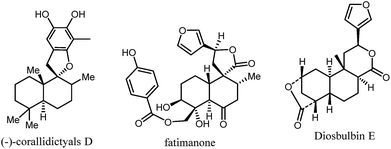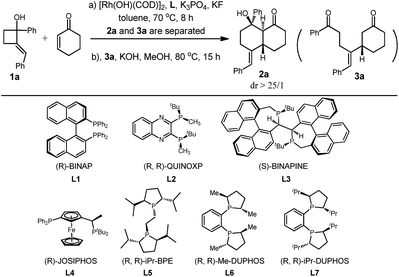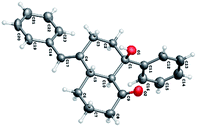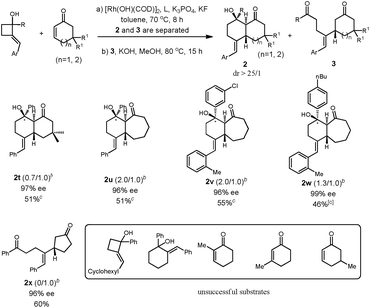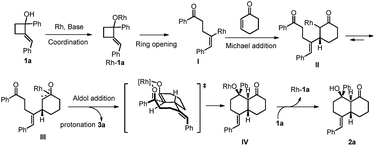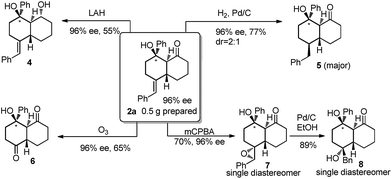 Open Access Article
Open Access ArticleCreative Commons Attribution 3.0 Unported Licence
Rhodium(I)-catalyzed asymmetric [4 + 2] cycloaddition reactions of 2-alkylenecyclobutanols with cyclic enones through C–C bond cleavage: efficient access to trans-bicyclic compounds†
Xinxin
Zheng
 a,
Rui
Guo
a,
Rui
Guo
 b,
Guozhu
Zhang
b,
Guozhu
Zhang
 *b and
Dayong
Zhang
*a
*b and
Dayong
Zhang
*a
aInstitute of Pharmaceutical Science, China Pharmaceutical University, Nanjing, P. R. China. E-mail: cpuzdy@163.com
bState Key Laboratory of Organometallic Chemistry, Center for Excellence in Molecular Synthesis, Shanghai Institute of Organic Chemistry, Chinese Academy of Sciences, 345 Lingling Road, Shanghai 200032, P. R. China. E-mail: guozhuzhang@sioc.ac.cn
First published on 8th January 2018
Abstract
We report a rhodium-catalyzed asymmetric formal intermolecular [4 + 2] cycloaddition reaction of 2-alkylenecyclobutanols with α,β-unsaturated cyclic ketones leading to synthetically useful trans-bicyclic molecules. Three consecutive stereogenic centers are formed in a highly enantio- and diastereoselective manner. Stepwise C–C bond cleavage and annulation are likely involved in the reaction pathway. Here, iPr-Duphos is the viable chiral ligand that promotes excellent enantio-control.
Introduction
Bicyclic rings are found in the skeletons of many terpenoid natural products such as (−)-corallidictyals, fatimanone, and diosbulbin E (Fig. 1).1 Terpenoids and synthetic small molecules containing bicyclic ring structures exhibit a wide range of important bioactivities.2 Intermolecular [4 + 2] cycloaddition to the C2–C3 positions of α,β-unsaturated cyclic ketones has high synthetic potential for the synthesis of structurally diverse and complex bicyclic systems.3 Among these, the Diels–Alder (DA) reaction constitutes one of the most widely used and efficient approaches.4 However, DA adducts generally possess cis configurations that are less common in natural products; meanwhile, asymmetric catalysis has had only limited success.5 Therefore, new catalytic methods for the expedient synthesis of bicyclic motifs in a trans- and enantioselective fashion are highly desirable.Studies of transition-metal-catalyzed selective cleavage of carbon–carbon single bonds as the initiation for further functionalizations have grown considerably in recent years due to the high potential of this strategy in synthesis.6 Cyclobutenols and cyclobutanols are privileged building blocks in this field.7 Murakami pioneered a series of studies on the rhodium-catalyzed tandem C–C single bond cleavage/formal cycloaddition of benzocyclobutenols with various functionalities including alkynes,7e,q vinyl ketones,7j carbene precursors,7l and allenes.7f As a special surrogate for benzocylobutenols, 2-alkylenecyclobutanols have attracted much less attention in the C–C bond cleavage research field.8 Therefore, the means to obtain 2-alkylidene cyclobutanols with similar reactivities of selective C–C bond cleavage and annulation would offer a new avenue to this rapidly expanding synthetic tool box eqn (1).
Inspired by Murakami’s work on the successful cycloaddition of benzocyclobutenol with acyclic alkyl vinyl ketones leading to tetralin skeletons,7j here we explore the feasibility of combining cyclic enones with 2-alkylenecyclobutanols and possible enantioinductions enabled by a proper chiral ligand. Thus, we report the highly efficient rhodium(I)-catalyzed formal [4 + 2] cycloaddition of 2-alkylene cyclobutanols with α,β-unsaturated cyclic ketones via a tandem C(sp2)–C(sp3) bond cleavage and cycloaddition leading to complex trans-bicyclic ring systems. Here, iPr-Duphos is the most effective chiral ligand to enable enantioselective transformation.
We began our studies by exploring the reaction of cyclohex-2-enone with (E)-2-benzylidene-1-phenylcyclobutanol. After numerous trials, the use of [Rh(COD)OH]2 catalyst and K3PO4 as the base produced the desired product 2a as a single diastereomer plus uncyclized 3a in a ratio of 1/1. Interestingly, 3a could be separated and converted to 2a by treatment with KOH in MeOH at 80 °C in 70% isolated yield as a single diastereomer, indicating that cyclization is highly stereospecific (Table 1, entry 1).9
| Entrya | L | 2a/3a | Yield (2a)b [%] | eec [%] |
|---|---|---|---|---|
| a Unless otherwise noted, two-step reactions were carried out: step a, 1a (0.2 mmol), cyclohexenone (2 equiv.), [Rh(COD)OH]2 (2.5 mol%), L (10 mol%), K3PO4 (2 equiv.), and KF (2 equiv.) were heated in toluene (0.2 M) at 70 °C for 8 h; step b, 3a (isolated from step a) and KOH (1.1 equiv.) were heated in MeOH (0.1 M) at 80 °C for 15 h. b The combined yield of the two steps. c The absolute configuration of the product was assigned by single crystal X-ray analysis of 2a. d Without KF. e The reaction conditions for step a were: 1a (0.2 mmol), cyclohexenone (2 equiv.), [Rh(COD)OH]2 (2.5 mol%), K2CO3 (1.1 equiv.), and 10% H2O in toluene (0.2 M) heated at 70 °C for 8 h. | ||||
| 1d | — | 1.0/1.0 | 30 | — |
| 2 | — | 2.1/1.0 | 60 | — |
| 3e | — | 0/1.0 | 49 | — |
| 4 | L1 | — | — | — |
| 5 | L2 | 1.0/1.0 | 30 | 0 |
| 6 | L3 | 1.0/2.0 | 43 | 27 |
| 7 | L4 | — | — | — |
| 8 | L5 | 1.2/1.0 | 28 | 87 |
| 9 | L6 | 1.2/1.0 | 27 | 96 |
| 10 | L7 | 1.9/1.0 | 60 | 96 |
To improve the yield of 2a, a range of additives was tested, and to our delight 60% yield of 2a was attained in the presence of KF, which likely facilitates the formation of enolate and the next aldol cyclization reaction (Table 1, entry 2).10 However, no further improvement in the yield of 2a or in the ratio of 2a over 3a was obtained after many experiments. We have emphasized the use of commercial chiral ligands for asymmetric carbon–carbon bond formation. Several representative phosphine ligands such as BINAP, QuinoxP*, Binapine, and Josiphos were ineffective at catalyzing the reaction. They resulted in either low yields or negligible enantiomer ratios of 2a (Table 1, entries 4 to 7). To our delight, a much improved enantioselectivity of 87% ee was obtained for 2a with L5 as the ligand (Table 1, entry 8). Further studies identified L7 as the most effective ligand of those tested—it resulted in 2a being obtained in 96% ee (Table 1, entry 10). Notably, the ee values of 3a and 2a are almost identical under these reaction conditions. Absolute configuration of the product was then determined with single crystal X-ray analysis of ent-2a (Fig. 2). Thus, the optimal conditions were identified to be a two-step procedure with L7 as the ligand.
We found a broad substrate scope with respect to R1 and R2 of cyclobutanol (Table 2). When R2 was a phenyl group, various cyclobutanols bearing para- and meta-substituted phenyl groups (R1) reacted well to give the desired products in moderate to satisfactory yields and high enantioselectivities (ee = 94–98%); the substitutions could be alkyl, methoxy, or fluoro groups (Table 2, entries 1–5). The 1-alkylated 2-alkylenecyclobutanols are suitable substrates as well, and the desired bicyclic products were obtained in moderate yields with excellent ee values (Table 2, entries 6, 7). The variation of substitutions on the alkylene was then briefly investigated, and to our delight arenes bearing electron-donating methyl and methoxy at either the para or ortho positions with various combinations of benzene substitutions (R1) were compatible with the reaction conditions (Table 2, entries 8–16). In addition, a chloro group on the para position of R2 was well tolerated (Table 2, entry 17). The reaction also proceeded well when a furyl group was employed (Table 2, entry 18).
| Entrya | Product | R1 | R2 | 2/3 | Yield (2)b [%] | eec [%] |
|---|---|---|---|---|---|---|
| a Unless otherwise noted, the two-step reactions were carried out under the optimized conditions (Table 1, entry 10). b Combined yield of the two steps. c The absolute configuration was assigned by analogy. | ||||||
| 1 | 2b | p-MeC6H4 | Ph | 1.1/1.0 | 55 | 98 |
| 2 | 2c | p-MeOC6H4 | Ph | 1.3/1.0 | 58 | 97 |
| 3 | 2d | p-FC6H4 | Ph | 1.9/1.0 | 62 | 97 |
| 4 | 2e | m-iPrC6H4 | Ph | 2.1/1.0 | 57 | 96 |
| 5 | 2f | p-nBuC6H4 | Ph | 1.7/1.0 | 56 | 94 |
| 6 | 2g | Me | Ph | 2.0/1.0 | 58 | 97 |
| 7 | 2h | Et | Ph | 2.7/1.0 | 58 | 97 |
| 8 | 2i | Ph | p-MeC6H4 | 2.8/1.0 | 57 | 95 |
| 9 | 2j | p-MeC6H4 | p-MeC6H4 | 1.4/1.0 | 57 | 99 |
| 10 | 2k | m-ClC6H4 | p-MeC6H4 | 2.6/1.0 | 66 | 96 |
| 11 | 2l | p-FC6H4 | p-MeC6H4 | 3.8/1.0 | 77 | 92 |
| 12 | 2m | Ph | o-MeC6H4 | 2.1/1.0 | 57 | 98 |
| 13 | 2n | p-nBuC6H4 | o-MeC6H4 | 4.4/1.0 | 56 | 99 |
| 14 | 2o | m-ClC6H4 | o-MeC6H4 | 3.0/1.0 | 68 | >99 |
| 15 | 2p | Ph | p-MeOC6H4 | 1.4/1.0 | 54 | 97 |
| 16 | 2q | p-MeC6H4 | p-MeOC6H4 | 4.2/1.0 | 78 | 99 |
| 17 | 2r | p-MeC6H4 | p-ClC6H4 | 3.6/1.0 | 78 | 99 |
| 18 | 2r | Ph | 2-Fural | 2.5/1.0 | 59 | >99 |
We then turned our attention to the variations of the α,β-unsaturated cyclic ketones. With 1a as the substrate, a variety of cyclohex-2-enones was tested under optimal conditions. The reaction appeared to be highly sensitive to the electronic and steric properties of the substitutions. Substrates with a methyl substituent either on the double bond or at the β-position to the carbonyl group did not give the desired products. To our delight, 5,5-dimethylcyclohex-2-enone reacted under standard conditions to provide the desired product in moderate yield and with an excellent ee value as expected. We then investigated other cyclic enones with different ring sizes. For cyclopent-2-enone, the diketone could be obtained in good yield with an excellent ee value; however, no cyclized product was observed under a number of different conditions. The cyclohept-2-enone underwent annulation with 1a under optimal conditions leading to the [4.5.0] bicyclic products in moderate yield with an excellent ee value. This represents another type of important molecular scaffold11 that is difficult to access using other methods (Table 3).
According to previous studies and our observations,7f,j a stepwise reaction mechanism has been proposed (Scheme 1). At the start, a well-established rhodium(I) cyclobutanolate formation and β-carbon elimination occur to afford the vinylrhodium species I. A highly enantioselective Michael addition to the cyclohexanone occurs to form the intermediate II that undergoes isomerization to give the enolate III.12 The intramolecular aldol type cyclization proceeds in a highly stereoselective manner. Hydrolysis affords the final bicyclic product with regeneration of the catalyst. Concurrently, protonation of III is another pathway to yield the uncyclized product 3a.
These series of bicyclic products are synthetically versatile building blocks due to the presence of several different functional groups for further elaborations (Scheme 2). For example, reduction of the ketone in 2a using LiAlH4 produced the corresponding diol 4 in 55% yield as a single diastereomer. Reductive hydrogenation of the exo alkene gave rise to 5 as two inseparable diastereomers (2/1 ratio), both with four consecutive stereogenic centers. The double bond could be cleaved by ozonolysis leading to diketone 6 with a slightly decreased ee value. Epoxidation and the ring opening sequence proceeded effectively to afford both 7 and 8 as single diastereomers.
Conclusions
In summary, we developed a rhodium(I)-catalyzed cycloaddition reaction of 2-alkylidene cyclobutanols with α,β-unsaturated cyclic ketones to form trans-bicyclic ketones containing three contiguous stereogenic centers in moderate yields with excellent enantioselectivities. Both [4.4.0] and [4.5.0] bicyclic systems are readily accessible in an optically pure form. The synthetic potential of the products was demonstrated via several easy derivatizations.Conflicts of interest
There are no conflicts to declare.Acknowledgements
Dedicated to Professor Jin-Pei Cheng on the occasion of his 70th birthday. We are grateful to NSFC-21421091, 21772218, 30973607, 81172934, and XDB20000000, the “Thousand Plan” Youth program, State Key Laboratory of Organometallic Chemistry, Shanghai Institute of Organic Chemistry, and the Chinese Academy of Sciences.Notes and references
-
(a) R. D. Gaikwad, M. D. Rane and S. V. Bhat, Tetrahedron: Asymmetry, 2017, 28, 181 CrossRef CAS
; (b) W. M. Heys and J. H. George, Org. Biomol. Chem., 2016, 14, 5546 RSC
; (c) H. Lee, Y. Kim, I. Choi, B. S. Min and S. H. Shim, Bioorg. Med. Chem. Lett., 2010, 20, 288 CrossRef CAS PubMed
; (d) L. Rakotobe, L. Mambu, A. Deville, L. Dubost, V. Jeannoda, D. Rakoto and B. Bodo, Phytochemistry, 2010, 71, 1007 CrossRef CAS PubMed
; (e) R. J. Peters, Nat. Prod. Rep., 2010, 27, 1521 RSC
; (f) L. Rakotobe, L. Mambu, A. Deville, L. Dubost and V. Jeannoda, Phytochemistry, 2010, 71, 1007 CrossRef CAS PubMed
.
-
(a) S. J. Dai, G. W. Qu, Q. Y. Yu, D. W. Zhang and G. S. Li, Fitoterapia, 2010, 81, 737 CrossRef CAS PubMed
; (b) R. A. Raccuglia, G. Bellone, K. Loziene, F. Piozzi, S. Rosselli, A. Maggio, M. Bruno and M. S. J. Simmonds, Phytochemistry, 2010, 71, 2087 CrossRef CAS PubMed
; (c) M. Sathe, R. Ghorpade, A. K. Srivastava and M. P. Kaushik, J. Ethnopharmacol., 2010, 130, 171 CrossRef CAS PubMed
.
-
(a) B. Bittner, K. Koppe, V. Bilir, W. Frank, H. Willner and N. Ignat’ev, J. Fluorine Chem., 2015, 169, 50 CrossRef CAS
; (b) T. Terada, Org. Lett., 2014, 16, 2594 CrossRef CAS PubMed
; (c) R. K. Schmidt, K. Müther, C. Lichtenfeld, S. Grimme and M. Oestreich, J. Am. Chem. Soc., 2012, 134, 4421 CrossRef CAS PubMed
; (d) J. Lee, Y. Zhang and S. J. Danishefsky, J. Am. Chem. Soc., 2010, 132, 14330 CrossRef CAS PubMed
; (e) H. F. T. Klare, K. Bergander and M. Oestreich, Angew. Chem., Int. Ed., 2009, 48, 9077 CrossRef CAS PubMed
; (f) H. Todo, J. Terao, H. Watanabe, H. Kuniyasu and N. Kambe, Chem. Commun., 2008, 1332 RSC
; (g) D. H. Ryu and E. J. Corey, J. Am. Chem. Soc., 2003, 125, 6388 CrossRef CAS PubMed
; (h) F. Fringuelli, F. Pizzo, A. Taticchi and E. Wenkert, J. Org. Chem., 1983, 48, 2802 CrossRef CAS
.
-
(a) Z. U. Din, T. P. Fill, M. C. Donatoni, C. A. Dos Santos, T. J. Brocksom and E. R. Filho, Mol. Diversity, 2016, 20, 877 CrossRef CAS PubMed
; (b) M. Schubert and P. Metz, Angew. Chem., Int. Ed., 2011, 50, 2954 CrossRef CAS PubMed
; (c) T. J. Brocksom and M. C. Donatoni, Quim. Nova, 2010, 33, 2211 CrossRef CAS
; (d) T. K. M. Shing, C. M. Lee and H. Y. Lo, Tetrahedron, 2004, 60, 9179 CrossRef CAS
.
-
(a) J. Ma, Y. Wang, Y. Liu, S. Gao, L. Ding, F. Zhao, L. Chen and F. Qiu, Fitoterapia, 2015, 103, 90 CrossRef CAS PubMed
; (b) C. M. Starks, R. B. Williams, M. G. Goering, M. O. Johnson, V. L. Norman, J. F. Hu, E. Garo, G. W. Hough, S. M. Rice and G. R. Eldridge, Phytochemistry, 2010, 71, 104 CrossRef CAS PubMed
.
- For selected reviews on C–C bond activation, see:
(a) L. Souillart and N. Cramer, Chem. Rev., 2015, 115, 9410 CrossRef CAS PubMed
; (b) G. Dong, Topics in Current Chemistry, Springer-Verlag, Berlin Heidelberg, 2014, vol. 346 Search PubMed
; (c) F. Chen, T. Wang and N. Jiao, Chem. Rev., 2014, 114, 8613 CrossRef CAS PubMed
; (d) Y. J. Park, J. W. Park and C. H. Junn, Acc. Chem. Res., 2008, 41, 222 CrossRef CAS PubMed
; (e) C. H. Jun, Chem. Soc. Rev., 2004, 33, 610 RSC
; (f) J. L. Beauchamps, Chem. Rev., 1990, 90, 629 CrossRef
; (g) I. Marek, A. Masarwa, P. O. Delaye and M. Leibeling, Angew. Chem., Int. Ed., 2015, 54, 414 CAS
; (h) A. Dermenci, J. W. Coe and G. Dong, Org. Chem. Front., 2014, 1, 567 RSC
; (i) K. Ruhland, Eur. J. Org. Chem., 2012, 14, 2683 CrossRef
; (j) C. Aïssa, Synthesis, 2011, 21, 3389 CrossRef
; (k) M. Murakami and T. Matsuda, Chem. Commun., 2011, 47, 1100 RSC
; (l) T. Seiser and N. Cramer, Org. Biomol. Chem., 2009, 7, 2835 RSC
; (m) H. Yorimitsu and K. Oshima, Bull. Chem. Soc. Jpn., 2009, 82, 778 CrossRef CAS
; (n) M. Murakami, M. Makino, S. Ashida and T. Matsuda, Bull. Chem. Soc. Jpn., 2006, 79, 1315 CrossRef CAS
; (o) J. A. Tunge and E. C. Burger, Eur. J. Org. Chem., 2005, 1715 CrossRef CAS
; (p) C. Perthuisot, B. L. Edelbach, D. L. Zubris, N. Simhai, C. N. Iverson, C. Muller, T. Satoh and W. D. Jones, J. Mol. Catal., 2002, 189, 157 CrossRef CAS
; (q) M. Murakami and Y. Ito, Top. Organomet. Chem., 1999, 3, 97 CrossRef CAS
.
-
(a) R. Guo and G. Zhang, J. Am. Chem. Soc., 2017, 139, 12891 CrossRef CAS PubMed
; (b) R. Guo, X. Zheng, D. Zhang and G. Zhang, Chem. Sci., 2017, 8, 3002 RSC
; (c) J. Yu, H. Yan and C. Zhu, Angew. Chem., Int. Ed., 2016, 55, 1143 CrossRef CAS PubMed
; (d) R. Ren, Z. Wu, Y. Xu and C. Zhu, Angew. Chem., Int. Ed., 2016, 55, 2866 CrossRef CAS PubMed
; (e) Q. Tian, B. Chen and G. Zhang, Green Chem., 2016, 18, 6236 RSC
; (f) C. Zhao, L. C. Liu, J. Wang, C. Jiang, Q. W. Zhang and W. He, Org. Lett., 2016, 18, 328 CrossRef CAS PubMed
; (g) R. Ren, H. Zhao, L. Huan and C. Zhu, Angew. Chem., Int. Ed., 2015, 54, 12692 CrossRef CAS PubMed
; (h) H. Zhao, X. Fan, J. Yu and C. Zhu, J. Am. Chem. Soc., 2015, 137, 3490 CrossRef CAS PubMed
; (i) N. Ishida, D. Nečas, Y. Masuda and M. Murakami, Angew. Chem., Int. Ed., 2015, 54, 7418 CrossRef CAS PubMed
; (j) N. Ishida, N. Ishikawa, S. Sawano, Y. Masuda and M. Murakami, Chem. Commun., 2015, 51, 1882 RSC
; (k) L. Souillart and N. Cramer, Chem. Sci., 2014, 5, 837 RSC
; (l) Y. Xia, Z. Liu, Z. Liu, R. Ge, F. Ye, M. Hossain, Y. Zhang and J. Wang, J. Am. Chem. Soc., 2014, 136, 3013 CrossRef CAS PubMed
; (m) A. Yada, S. Fujita and M. Murakami, J. Am. Chem. Soc., 2014, 136, 7217 CrossRef CAS PubMed
; (n) N. Ishida, Y. Nakanishi and M. Murakami, Angew. Chem., Int. Ed., 2013, 52, 11875 CrossRef CAS PubMed
; (o) N. Ishida, Y. Shimamoto, T. Yano and M. Murakami, J. Am. Chem. Soc., 2013, 135, 19103 CrossRef CAS PubMed
; (p) T. Matsuda and N. Miura, Org. Biomol. Chem., 2013, 11, 3424 RSC
; (q) N. Ishida, S. Sawano, Y. Masuda and M. Murakami, J. Am. Chem. Soc., 2012, 134, 17502 CrossRef CAS PubMed
; (r) T. Seiser and N. Cramer, J. Am. Chem. Soc., 2010, 132, 5340 CrossRef CAS PubMed
; (s) M. Shigeno, T. Yamamoto and M. Murakami, Chem.–Eur. J., 2009, 15, 12929 CrossRef CAS PubMed
; (t) T. Seiser, O. A. Roth and N. Cramer, Angew. Chem., Int. Ed., 2009, 48, 6320 CrossRef CAS PubMed
; (u) T. Seiser and N. Cramer, Angew. Chem., Int. Ed., 2008, 47, 9294 CrossRef CAS PubMed
; (v) T. Matsuda, M. Makino and M. Murakami, Org. Lett., 2004, 6, 1257 CrossRef CAS PubMed
; (w) T. Nishimura, K. Ohe and S. Uemura, J. Am. Chem. Soc., 1999, 121, 2645 CrossRef CAS
.
-
(a) Y. Zhou, C. Rao and Q. Song, Org. Lett., 2016, 18, 4000 CrossRef CAS PubMed
; (b) T. Liu, J. Wu and Y. Zhao, Chem. Sci., 2017, 8, 3885 RSC
.
- P. Yates, S. P. Douglas, S. K. Datta and J. F. Sawyer, Can. J. Chem., 1988, 66, 2268 CrossRef CAS
.
-
(a) C. Yan and J. Sun, Synth. Commun., 2000, 30, 3809 CrossRef CAS
; (b) V. Raju, R. Radhakrishnan, S. Jaenicke and G. K. Chuah, Catal. Today, 2011, 164, 139 CrossRef CAS
.
-
(a) W. Zhang, M. R. Collins, K. Mahmood and P. Dowd, Tetrahedron Lett., 1995, 36, 2729 CrossRef CAS
; (b) U. P. Dhokte, P. M. Pathare, V. K. Mahindroo and H. C. Brown, J. Org. Chem., 1998, 63, 8276 CrossRef CAS
; (c) Y. M. A. Yamada, Chem. Pharm. Bull., 2017, 65, 805 CrossRef PubMed
.
- N. Tokunaga, K. Yoshida and T. Hayashi, Proc. Natl. Acad. Sci. U. S. A., 2004, 101, 5445–5449 CrossRef CAS PubMed
.
Footnote |
| † Electronic supplementary information (ESI) available. CCDC 1575240. For ESI and crystallographic data in CIF or other electronic format see DOI: 10.1039/c7sc04784c |
| This journal is © The Royal Society of Chemistry 2018 |

